Why do currant leaves curl and what to do about it?
Gardeners often encounter a problem when, during the fruiting period, currant leaves curl, quickly lose color, dry out and fall off. This means that crop losses are inevitable. To save the bush, it is important to find out who is to blame - pests or diseases. In this article we will look at why leaves curl and what to do about it.
Why do currant leaves curl?
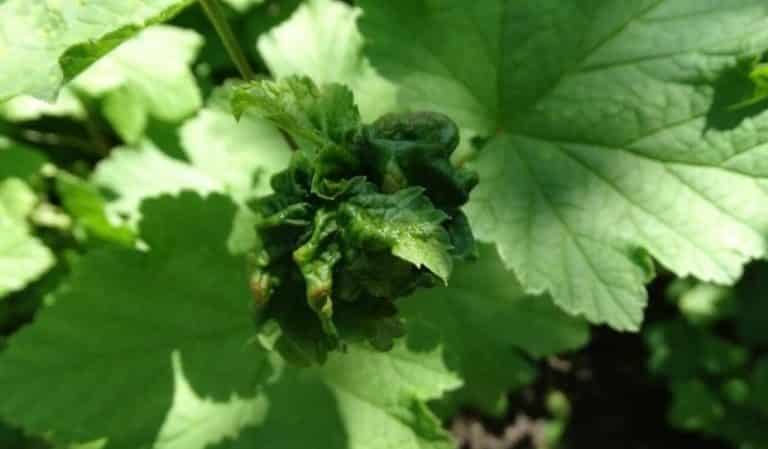
Currants are susceptible to pathogens and insects. The risk of damage depends on the type of plant. So, black currant suffers from pests much less than red. Specific pests are leaf rollers, aphids, spider mites, glass beetles.
A damaged plant is stunted, withers, stops bearing fruit, and then dies prematurely. If currant leaves curl, you need to unfold them and carefully inspect them for the presence of larvae, cobwebs, growths and spots.
leaf roller
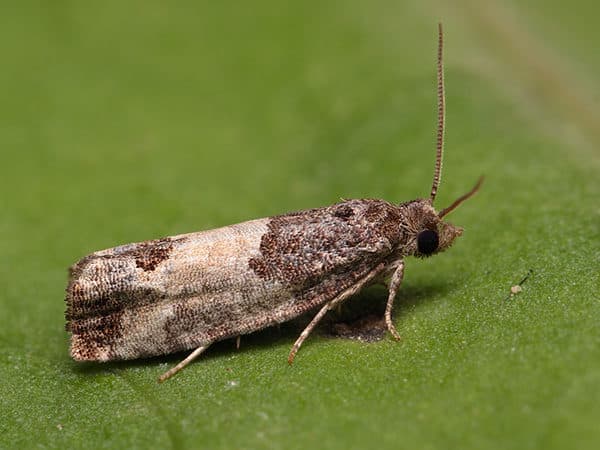
Currants are often attacked by the crooked leaf roller, a medium-sized butterfly 10-20 mm long. Mature individuals have a light green or green color. The fore wings are ocher or brown, the hind wings are dark gray with a yellow edge.
Insects feed on all parts of the plant, but most often attack the leaves. A characteristic feature is a cobweb, a viscous secretion secreted by leaf rollers for better bonding during the period of twisting the leaves around themselves.
For reference. Curled leaves should be torn off and burned. You cannot leave them in a compost heap or near the trunk of a plant.Otherwise, the larvae will overwinter safely, and the leaf roller invasion will repeat in the spring.
Means for fighting
Gardeners distinguish 3 ways to influence insects:
- Traditional methods. Garlic infusion: for 1 liter of boiled water, 1 clove of chopped garlic. Leave the concentrate for 5-7 days. Before irrigation, dilute in water in proportions of 60 ml per 10 liters of water.
- Bioinsectoacaricides. These drugs are safe for humans and non-phytotoxic.
- Insecticides. The greatest efficiency and fastest results are achieved using chemicals. They are toxic, so their help is resorted to in extreme cases, when the affected area is large, and biological products and traditional methods are ineffective.
Bioinsectoacaricides
Most popular:
- "Aktofit". Kills pests 3-8 days after treatment. Dissolve 2 ml in 1 liter of water. Pour the required amount into 0.5 liters of water, stirring constantly. Pour the resulting solution into a 1/3 filled sprayer tank. Close, shake 2-3 times and start processing.
- "Lepidocide." The action of the drug is aimed at destroying caterpillars. The death of pests is observed on 2-3 days. The plant is treated at least 2 times during the growing season at intervals of a week. Dosage - 20-30 ml per 10 liters of water. The average solution consumption is 2-5 liters per adult bush.
Insecticides
Examples of drugs:
- "Kinmiks." Use against larvae and adults no more than 2 times per season, since the product causes resistance. In case of overdose, the plant is inhibited, so the instructions should be strictly followed. For 1 bush, 1-1.5 liters of solution is enough. To prepare it, 2.5 ml of the product is diluted in 1.2 liters of water. While stirring, add more water to a total volume of 10 liters.The last treatment is carried out no later than 14 days before harvest. Can be alternated with other insecticides.
- "Karbofos". Used when buds open and during the appearance of buds. Proportions for dilution: 75 g per 10 liters. This volume is enough for 6-7 plants. On average, 1 adult bush requires 1.5 liters of solution. The soil and grass around are treated in the same way.
Aphid
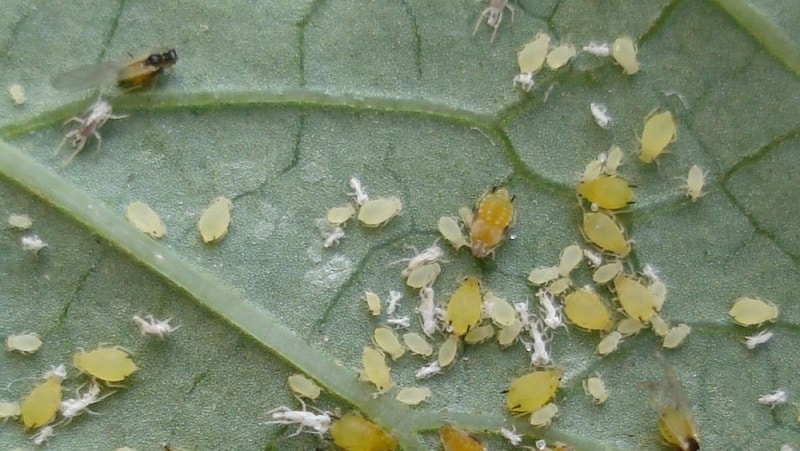
Currants are often attacked by gall (red currant) aphids. These are small, almost transparent insects of a pale green-yellow hue, without wings. The presence of a pest can be easily determined by the appearance of brown and yellow swellings on the top of the leaf. Gradually, the tubercles begin to darken, and the leaves of the currant curl. How to treat the plant depends on the insect’s development cycle. For sexually mature individuals, the use of insecticides is optimal. If you have to get rid of a clutch of eggs, it is better to use traditional methods.
Aphids spoil currant leaves until mid-July, after which they move to other plants. Egg laying occurs in autumn. They overwinter safely on branches; the larvae appear in early spring.
For reference. Gall aphids rarely settle on black currants, preferring colored varieties. They have thinner leaves, making it easier for insects to pierce them and extract juice.
Folk remedies
The following methods are popular among gardeners:
- Irrigation of bushes with boiling water. Ideal for controlling egg laying. After boiling, the water is poured into a watering can with a diffuser and the plants are irrigated abundantly. After a hot shower, it is recommended to treat the trunks with lime, which also helps destroy the eggs.
- Baking soda solution. The plant is treated in early spring, when the buds have not yet opened.40 g of grated laundry soap are diluted in 10 liters of water, sodium bicarbonate is added at the rate of 2 tbsp. l. for 1 l.
- Soap solution. In its pure form it is effective if aphids have just appeared on the plant. Rub 1.5 pieces of laundry soap and completely dissolve in 2 liters of warm water. Then add another 8 liters of water. Strain before using in a spray bottle.
- Decoction of celandine. 4 kg of crushed plant is poured into 10 liters of water and left for 4-5 hours. The liquid will turn dark brown. Strain and begin processing the bushes.
Biological drugs
Safe for humans and does not harm the plant. Actively used during the fruiting period. You can use “Actofit” (as when fighting leaf rollers) or give preference to “Fitoverm”.
The death of pests occurs 2-3 days after the initial treatment of the plant. Consumption of the drug is 2 ml per 1 liter of water. “Fitoverm” is used as pests appear during the growing season. 2-3 treatments with a time interval of 5-7 days are enough.
Chemicals
Toxic, do not use during fruiting period. After rains, re-treatment is necessary. The use of insecticides is justified when insects attack in large numbers and when other methods have proven ineffective.
Important! Harvesting begins no earlier than 20-30 days after the last treatment with insecticides.
Most in demand:
- "Aktellik". A product with a high rate of destruction and suppression of pests. Dosage - 1.5-2 ml per 1 liter of water. 2 treatments with an interval of 5-7 days are enough. Well compatible with biological products.
- "Biotlin." Complete death of pests occurs 3-4 hours after treatment. Dosage - 3 ml per 10 liters of water. The consumption rate depends on the size of the bush - from 0.5 to 1.5 liters.
Spider mite
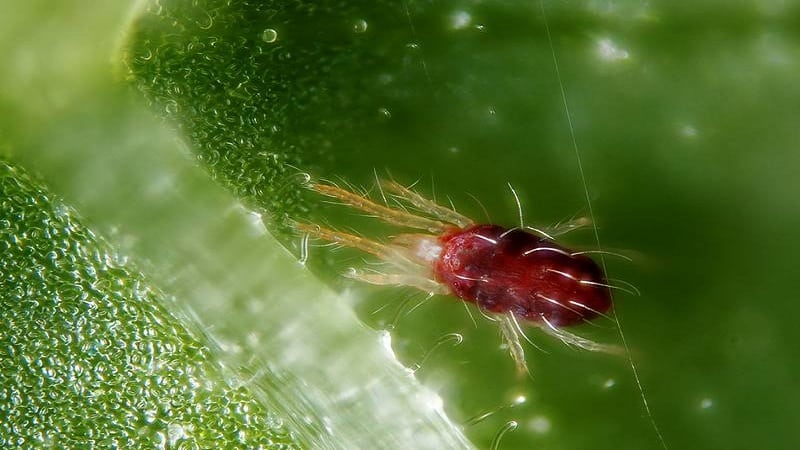
The appearance of a mite can be recognized by a thin gray spider web, yellowing and curling of leaf blades, and weakened growth of bushes. Due to the small size of the pest, it is very difficult to notice in time. Infection usually begins with the lower leaves, gradually spreading to the upper young ones. It is recommended to carefully inspect the oldest leaves for spotting. Larvae and adult ticks are localized on their lower parts.
Timely detection of ticks is the key to effective treatment. Active period reproduction falls in the second half of spring.
Folk remedies
It is better to irrigate the bushes with infusions with a repellent odor:
- Garlic. Pour 5 cloves of chopped garlic into 1 liter of cold water. Leave for 10-12 hours until air bubbles appear. Strain, dilute with water in a 1:1 ratio, spray on the bushes. Repeat treatment after 2-3 weeks.
- Tobacco. Pour 250 g of dry leaves, dust or crumbs into 2.5 liters of hot water. Leave for a day. Strain, add another 0.5 liters of water. For better adhesion of the product to the leaves, you can add 20 g of grated laundry soap.
- Herbal. Wormwood, celandine, and calendula are suitable. For 10 liters of hot water - 100-120 g of herbal raw materials. Leave for 2-3 hours. Strain before irrigating.
Colloidal sulfur can also be used to suppress ticks and prevent their spread.
Biological products
What to do if leaves curl due to mite activity:
- Use "Fitoseiulus". It contains live predatory mites that eat their arachnid counterparts. With a rapidly growing population, 20-50 individuals of predatory mites are evicted per 1 m² every 14 days. After the arachnids are destroyed, the biopredator also dies.
- Apply "Bitoxibacillin". Most effective at the larval stage of pests. The powder consumption rate is 80-100 per 10 liters of water. The last treatment is carried out 5 days before harvest.
Acaricides and insectoacaricides
Spider mites are not insects, they belong to the class of arachnids, so it is irrational to use insecticides. Ticks are adversely affected by acaricides and insectoacaricides. Usually 2 applications per season are sufficient, excluding currant flowering time.
Important! For safety, it is better to carry out chemical treatment in dry and windless weather, using personal protective equipment.
Most often used:
- "STOP tick." Does not affect the growth and development of the plant. Kills pests in the first minutes of treatment. The drug acts at all stages of insect development and has a long period of protective action. Consumption rate: 7 ml per 5-6 liters of water.
- "Envidor". Effective at all stages of pest development. Used on fruit and berry bushes twice per season, no later than 20 days before harvest. Can be used in rainy weather. Consumption rate: 2-3 ml per 5 liters of water.
- "Sunmite." Effective against not only ticks, but also other insects. It is better to use during the period of active flowering. It has good absorbency, so it does not require re-treatment after precipitation. One procedure per season is enough. Consumption rate: 5 g per 5 liters of water.
Glassware
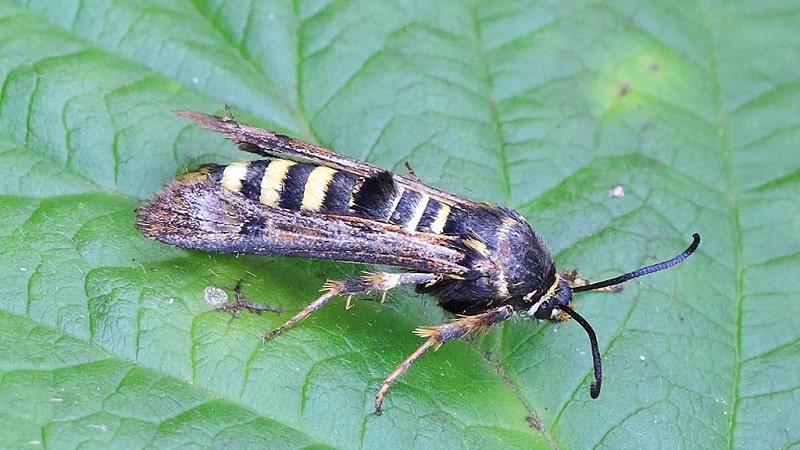
These are caterpillars with a whitish body and a black head. The pest prefers young blackcurrant bushes. The caterpillars appear at the end of June. They move along the entire shoot down to the root, gnawing out the core and leaving a hollow space. When a branch is cut longitudinally, the passage with the caterpillar or its excrement is clearly visible.Damaged shoots stop growing, dry out and break off. The bush bears fruit poorly, the berries become sour.
How to destroy
The caterpillar overwinters in the branches, so when a pest is detected, you need to cut off and eliminate dry shoots. The procedure is carried out throughout the entire growing season.
Traditional methods are aimed at scaring away adults. For this purpose, homemade traps are used. Red or yellow cardboard is used as bait, and jars of molasses are placed underneath it. The bright color attracts butterflies, but they are unable to latch onto the cardboard and fall into a jar of sticky substance. To deter them, small rags soaked in gasoline are hung on the bushes. The pungent smell interrupts the aroma of currants and prevents butterflies from detecting them.
For reference. They begin to process currants as soon as at least one of the adult individuals falls into the trap.
Biological insecticides, for example, Bitoxibacillin, can only be used at the prevention stage.
Chemicals
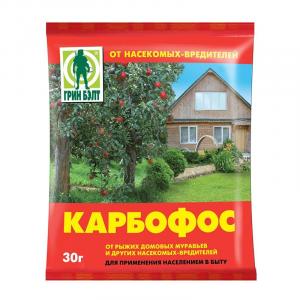
Only chemicals help in pest control:
- "Karbofos". You can use a 10% solution of the drug. The first treatment is carried out in early spring (before the buds open), the second - after flowering. Consumption rate: 30 g per 4 liters of water. 1-2 liters is enough for one bush.
- "Inta-Vir". Used before currants bloom. For 10 liters of warm water, 1 tablet is enough. It is ground and diluted in 300 g of water, then another 700 g is added and stirred. The mother liquor is ready. Then add water to the required level, shake it up and begin irrigation.
If complex measures are ineffective, the damaged bush is cut off at the root and burned.
Pest Prevention
Preventive procedures are carried out in the fall so that pests have no chance of laying eggs:
- Additionally, they are treated with insecticides if the bush has been affected by pests. The procedure is also carried out in the spring, before the buds open.
- They do sanitary and regulatory pruning. Remove weak, diseased, dried and thickening branches of the bush. The cut areas are treated with garden varnish.
- After leaf fall abundantly watered The crown and trunk circle are carefully loosened so as not to touch the surface roots. You can sprinkle with wood ash, mustard or ground pepper.
- Yellowed leaves are collected and burned.
- Plants with a pronounced aroma (garlic, onion, calendula, etc.) are planted near currants.
To prevent the penetration of larvae into the plant bark, all maintenance work is carried out as carefully as possible, without damaging the bark.
Conclusion
If currant leaves curl, it is important to understand what kind of pest is attacking and what to treat, because the safety of the crop is at stake. For some pests, folk remedies are sufficient; to combat others, you will have to use several types of insecticides per season.